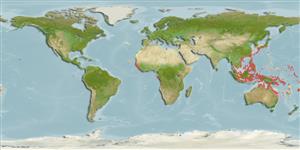Common names from other countries
Environment: milieu / climate zone / depth range / distribution range
Ecologie
; brakwater. Tropical
Eastern Central Atlantic and Western Pacific.
Length at first maturity / Size / Gewicht / Leeftijd
Maturity: Lm ? range ? - ? cm
Common in estuaries (Ref. 2925). Inhabits muddy sandflats and seagrass areas (Ref. 85382), also on seaweed in bays (Ref. 75835). Part of both epibenthic and arboreal communities in mangrove areas (Ref. 128397). Also found in sandy shores, near the vicinity of the depression formed during low tides to avoid desiccation (Ref. 125338).
Life cycle and mating behavior
Geslachtsrijpheid | Voortplanting | Kuitschieten | Eieren | Fecundity | Larven
Members of the order Neritopsina are mostly gonochoric and broadcast spawners. Life cycle: Embryos develop into planktonic trocophore larvae and later into juvenile veligers before becoming fully grown adults.
Smith, B.D. 2003. (Ref. 3116)
Status op de Rode Lijst van het IUCN (Ref. 130435)
Status bij CITES (Ref. 108899)
Not Evaluated
Not Evaluated
Gevaarlijk voor mensen
Harmless
Gebruik door de mens
| FishSource |
Tools
Meer informatie
Leeftijd/GrootteGroeiLengte-gewicht parametersLengte-lengte parametersMorfologieLarvenAbundantie
Internet-bronnen
Estimates based on models
Preferred temperature
(Ref.
115969): 25.5 - 29.3, mean 28.6 (based on 1804 cells).
